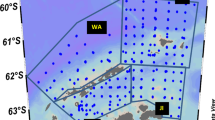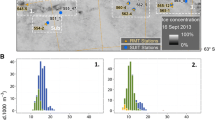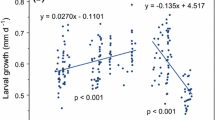Abstract
A quantitative characterization of growth-related parameters for larval and juvenile Antarctic krill, Euphausia superba (Dana), is essential to understanding the early life history of this key species in the Southern Ocean ecosystem. To this end, instantaneous growth rate experiments were conducted with larval and juvenile krill to determine growth increments and molting frequency in situ. All experiments were carried out during fall and winter months (April through September) on nine separate cruises west of the Antarctic Peninsula between 1987 and 1999. A consistent seasonal pattern across years was observed: growth rates decreased during fall (April/May), were minimal in early winter (June), and increased to maximum rates by late winter (September). Habitat-specific differences (water column vs under-ice) in growth rates of larvae collected on the same cruise were not observed in early winter (June 1993; within-year comparison). However, in a between-year comparison, larvae from the under-ice habitat (June/July 1987) had significantly higher growth increments than larvae from the open-water habitat (July 1989). The difference between these two comparisons may be a function of the degree of contrast in food availability in the water column and the sea ice at different times in the winter. Daylength at the time of collection explained 74% of the variation in larval and juvenile growth rates. This correlation may be an indirect effect of the influence of diel cycles on krill behavior and/or primary production in both the water column and ice.








Similar content being viewed by others

References
Berg A, Stefansson S, Hansen T (1994) Effect of reduced daylength on growth, sexual maturation and smoltification in Atlantic salmon (Salmo salar) underyearlings. Aquaculture 121:294
Boeuf G, LeBail PY (1999) Does light have an influence on fish growth? Aquaculture 177:129–152
Brinton E, Townsend AW (1984) Regional relationships between development and growth in larvae of Antarctic krill, Euphausia superba from field samples. J Crustac Biol 4:224–246
Brinton E, Huntley M, Townsend AW (1986) Larvae of Euphausia superba in the Scotia Sea and Bransfield Strait in March 1984–Development and abundance compared with 1981 larvae. Polar Biol 5:221–234
Buchholz F, Morris DJ, Watkins JL (1989) Analyses of field moult data: prediction of intermoult period and assessment of seasonal growth in Antarctic krill, Euphausia superba Dana. Antarct Sci 1:301–306
Croxall J, Prince P, Reid K (1999) Diet, provisioning and productivity responses of marine predators to differences in availability of Antarctic krill. Mar Ecol Prog Ser 177:115–131
Daly KL (1990) Overwintering development, growth and feeding of larval Euphausia superba in the Antarctic marginal ice zone. Limnol Oceanogr 35:1564–1576
Daniels WH, Dabramo LR, Graves KF (1994) Ovarian development of female red swamp crayfish (Procambrus clarkii) as influenced by temperature and photoperiod. J Crustac Biol 14:530–537
Dieckmann GS, Eicken H, Haas C, Garrison DL, Gleitz M, Lange M, Nothig E-M, Spindler M, Sullivan CW, Thomas DN, Weissenberger J (1998) A compilation of data on sea ice algal standing crop from the Bellingshausen, Amundsen and Weddell Seas from 1983 to 1994. In: Lizotte MP, Arrigo KR (eds) Antarctic sea ice: biological processes, interactions and variability. Antarct Res Ser 73:85–92
Elias MC (1990) Effects of photoperiod, phytoplankton level and temperature on the growth, development and survival of larval Euphausia superba (Dana). Master of Arts in Biology, University of California, Santa Barbara
Everson I (2000) Role of krill in marine food webs: the Southern Ocean. In: Everson I (ed) Krill: biology, ecology and fisheries. Blackwell, Oxford, pp 194–201
Fraser FC (1936) On the development and distribution of the young stages of krill (Euphausia superba). Discov Rep 14:1–192
Frazer TK (1996) Stable isotope composition (δ13C and δ15N) of larval krill, Euphausia superba, and two of its potential food sources in winter. J Plankton Res 18:1413–1426
Frazer TK, Quetin LB, Ross RM (1997a) Abundance and distribution of larval krill, Euphausia superba, associated with annual sea ice in winter. In: Battaglia B, Valencia J, Walton DWH (eds) Antarctic communities: species, structure and survival. Cambridge University Press, Venice, Italy, pp 107–111
Frazer TK, Ross RM, Quetin LB, Montoya JP (1997b) Turnover of carbon and nitrogen during growth of larval krill, Euphausia superba Dana: a stable isotope approach. J Exp Mar Biol Ecol 212:259–275
Frazer TK, Quetin LB, Ross RM (2002) Abundance, sizes and developmental stages of larval krill, Euphausia superba, during winter in ice-covered seas west of the Antarctic Peninsula. J Plankton Res 24:1067–1077
Garrison DL, Buck KR (1991) Surface-layer sea ice assemblages in Antarctic pack ice during the austral spring: environmental conditions, primary production and community structure. Mar Ecol Prog Ser 75:161–172
Guzman O (1983) Distribution and abundance of Antarctic krill (Euphausia superba) in the Bransfield Strait. In: Schnack SB (ed) On the biology of krill Euphausia superba. Alfred-Wegener-Insitute for Polar Research, Bremerhaven, pp 169–190
Hamner WM, Hamner PP, Strand SW, Gilmer RW (1983) Behavior of Antarctic krill, Euphausia superba: chemoreception, feeding, schooling and molting. Science 220:433–435
Hofmann EE, Lascara CM (2000) Modelling the growth dynamics of Antarctic krill Euphausia superba. Mar Ecol Prog Ser 194:219–231
Houde ED (1987) Fish early life dynamics and recruitment variability. Am Fish Soc Symp 2:17–29
Ikeda T (1984) Development of the larvae of the Antarctic krill (Euphausia superba Dana) observed in the laboratory. J Exp Mar Biol Ecol 75:107–117
Marschall H-P (1985) Structural and functional analyses of the feeding appendages of krill larvae. In: Siegfried WR, Laws RM, Condy PR (eds) Antarctic nutrient cycles and food webs. Springer, Berlin Heidelberg New York, pp 346–354
Marschall H-P (1988) The overwintering strategy of antarctic krill under the pack-ice of the Weddell Sea. Polar Biol 2:245–250
Matsuda H, Takenouchi T, Yamakawa T (2002) Effects of photoperiod and temperature on ovarian development and spawning of the Japanese spiny lobster Panulirus japonicus. Aquaculture 205:385–398
Mauchline J (1980) Measurement of body length of Euphausia superba Dana. BIOMASS handbook no. 4, SCAR/SCOR/IABO/ACMRR
McClatchie S, Rakusa-Suszczewski S, Filcek K (1991) Seasonal growth and mortality of Euphausia superba in Admiralty Bay, South Shetland Islands, Antarctica. ICES J Mar Sci 48:335–342
Nast F (1978) Vertical distribution of larval and adult krill (Euphausia superba Dana) on a time station south of Elephant Island, South Shetlands. Meeresforschung 27:103–118
Nelson K (1986) Photoperiod and reproduction in lobsters (Homarus). Am Zool 26:447–457
Nicol S (2000) Understanding krill growth and aging: the contribution of experimental studies. Can J Fish Aquat Sci 57:168–177
Nicol S, Stolp M, Cochran T, Geijsel P, Marshall J (1992) Growth and shrinkage of Antarctic krill (Euphausia superba Dana) from the Indian sector of the Southern Ocean during summer. Mar Ecol Prog Ser 89:175–181
Ottersen GB, Loeng H (2000) Covariability in early growth and year-class strength of Barents Sea cod, haddock and herring: the environmental link. ICES J Mar Sci 57:339–348
Quetin LB, Ross RM (1991) Behavioral and physiological characteristics of the Antarctic krill, Euphausia superba. Am Zool 31:49–63
Quetin LB, Ross RM (2003) Episodic recruitment in Antarctic krill, Euphausia superba, in the Palmer LTER study region. Mar Ecol Prog Ser (in press)
Quetin LB, Ross RM, Clarke A (1994) Krill energetics: seasonal and environmental aspects of the physiology of Euphausia superba. In: El-Sayed S (ed) Southern Ocean ecology: the BIOMASS perspective. Cambridge University Press, Cambridge, pp 165–184
Quetin LB, Ross RM, Frazer TK, Haberman KL (1996) Factors affecting distribution and abundance of zooplankton, with an emphasis on Antarctic krill, Euphausia superba. In: Ross RM, Hofmann EE, Quetin LB (eds) Foundations for ecological research west of the Antarctic Peninsula. American Geophysical Union, Washington, DC, pp 357–371
Reid K (2001) Growth of Antarctic krill Euphausia superba at South Georgia. Mar Biol 138:57–62
Ross RM, Quetin LB (1989) Energetic cost to develop to the first feeding stage of Euphausia superba Dana and the effect of delays in food availability. J Exp Mar Biol Ecol 133:103–127
Ross RM, Quetin LB (1991) Ecological physiology of larval euphausiids, Euphausia superba (Euphausiacea). Mem Queensl Mus 31:321–333
Ross RM, Quetin LB, Kirsch E (1988) Effect of temperature on developmental times and survival of early larval stages of Euphausia superba Dana. J Exp Mar Biol Ecol 121:55–71
Ross RM, Quetin LB, Baker KS, Vernet M, Smith RC (2000) Growth limitation in young Euphausia superba under field conditions. Limnol Oceanogr 45:31–43
Siegel V, Loeb V (1995) Recruitment of Antarctic krill (Euphausia superba) and possible causes for its variability. Mar Ecol Prog Ser 123:45–56
Siegel V, Nicol S (2000) Population parameters. In: Everson I (ed) Krill: biology, ecology and fisheries. Blackwell, Oxford, pp 103–149
Smetacek V, Scharek R, Nothig E-M (1990) Seasonal and regional variation in the pelagial and its relationship to the life history cycle of krill. In: Kerry KR, Hempel G (eds) Antarctic ecosystems: ecological change and conservation. Springer, Berlin Heidelberg New York, pp 103–114
Smith RC, Baker KS, Dustan P (1981) Fluorometer techniques for measurement of oceanic chlorophyll in the support of remote sensing. Scripps Institution of Oceanography, University of California, ref. 81-17, La Jolla
Smith RC, Dierssen H, Vernet M (1996) Phytoplankton biomass and productivity in the western Antarctic Peninsula region. In: Ross RM, Hofmann EE, Quetin LB (eds) Foundations for ecological research west of the Antarctic Peninsula. American Geophysical Union, Washington, DC, pp 333–356
Stammerjohn SE, Smith RC (1996) Spatial and temporal variability of western Antarctic Peninsula sea ice coverage. In: Ross RM, Hofmann EE, Quetin LB (eds) Foundations for ecological research west of the Antarctic Peninsula. American Geophysical Union, Washington, DC, pp 81–104
Stammerjohn SE, Baker KS, Smith RC (1997) Sea ice indexes for Southern Ocean regional marine ecology studies. Scripps Institution of Oceanography, University of California, ref. 97-01, La Jolla
Stretch JJ, Hamner PP, Hamner WM, Michel WC, Cook J, Sullivan CW (1988) Foraging behavior of antarctic krill Euphausia superba on sea ice microalgae. Mar Ecol Prog Ser 44:131–139
Tilzer MM, Dubinsky Z (1987) Effects of temperature and daylength on the mass balance of Antarctic phytoplankton. Polar Biol 7:35–42
Waddy SL, Aiken DE (1991) Egg production in the American lobster, Homarus americanus. In: Wenner A, Kuris A (eds) Crustacean egg production. Balkema, Rotterdam, pp 267–290
Acknowledgements
These experiments were conducted over an extended period of time. We wish to gratefully acknowledge the help of the many individuals on the nine research teams and the captains and crews of the research vessels during the fall and winter cruises. This study would have been impossible without their assistance. This material is based upon work supported by the National Science Foundation under award nos. DPP-8518872, DPP-8820589, and OPP-9117633 (for the WinCruises), and award nos. OPP-9011927 and OPP-9632763, and by the Regents of the University of California and the University of California at Santa Barbara through the LTER cruises. This is Palmer LTER contribution no. 231. The experiments complied with the current laws of the USA.
Author information
Authors and Affiliations
Corresponding author
Additional information
Communicated by J.P. Grassle, New Brunswick
Rights and permissions
About this article
Cite this article
Quetin, L.B., Ross, R.M., Frazer, T.K. et al. Growth of larval krill, Euphausia superba, in fall and winter west of the Antarctic Peninsula. Marine Biology 143, 833–843 (2003). https://doi.org/10.1007/s00227-003-1130-8
Received:
Accepted:
Published:
Issue Date:
DOI: https://doi.org/10.1007/s00227-003-1130-8



